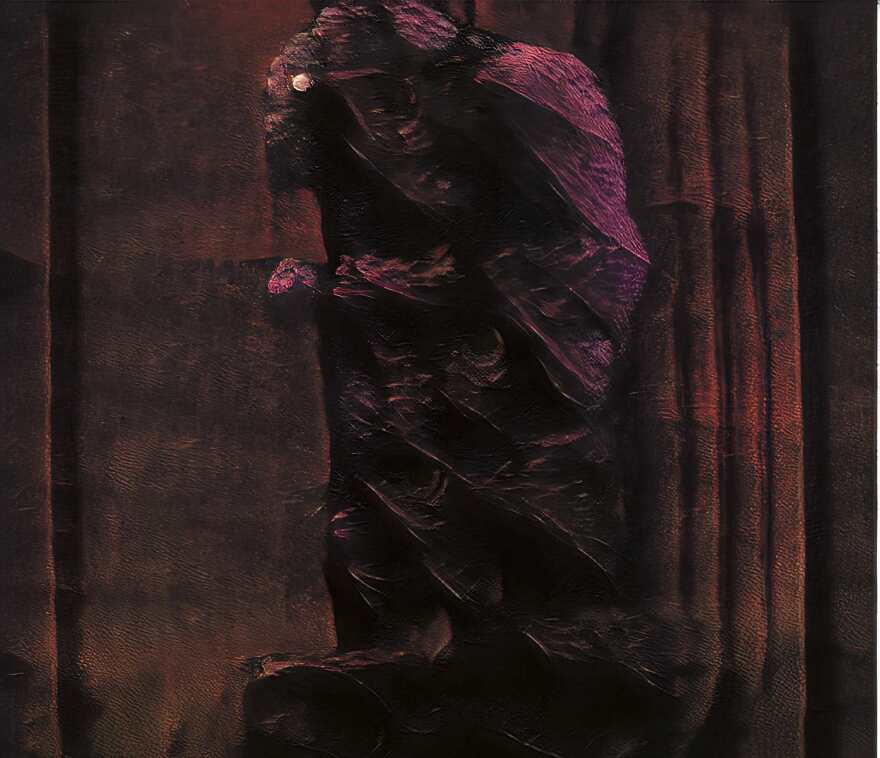Artificial Intelligence: “Terrifying, alien, relatable in an odd sense, captivating and uncanny.” That’s how one 16-year-old describes the complex world he works in.
Rio Harper is an 11th-grade student. Rio built an AI program that creates digital art. Rio has made over $100,000. Rio plans on going to college. Rio is worried about the future.
Within the small, sleepy village of Cazenovia, Rio’s home is constantly bustling with noise and energy. Among the loud calls for “dinner!” and incessant barking of his two dogs, Rio lives with his parents, his younger sister and a foreign exchange student from Pakistan. However, Rio is able to retreat to a quieter space: his neatly-curated upstairs bedroom.
Among the bed, closet and side table stands a computer that radiates a rainbow of neon colors, straight out of a Blade Runner movie, and a curved screen that would feel at home on the bridge of some fictional spaceship. This is where Rio is able to work on his sci-fi-esque passion project.
Rio is a deep-voiced yet soft-spoken teen who has a deep-seeded passion for the technological. Growing up, Rio was often likened to a young Bill Gates or Elon Musk: a little socially awkward but kind, caring and aggressively passionate about exploring any and every new opportunity he could find.
“We never really had to push him. He is just who he is and we do our best to make sure he has room to be himself,” said Ken Harper, Rio’s dad. “He’s like the crazy cyberpunk artist in his bedroom concocting some juicy new visuals.”
At 10 years old, Rio built a computer for a college student and at 14, Rio built a Twitter bot that created tweets based on its followers’ previous tweets. When Rio was 15, he found a new challenge: How can he make art for his art class when the best he could draw were stick figures?

Rio goes to Cazenovia High School and, in the early months of 2020, his school shut down in the midst of the COVID-19 pandemic. After his school went online, Rio found himself with ample time but little motivation to continue completing school assignments that often felt arbitrary to him. So, in light of feeling like he wasn’t applying himself enough, he decided to pick up a hobby; he decided to pick up AI.
Rio wasn’t interested in the classic “serious statistics” side of AI as he put it, so he decided to explore how he could use his new hobby to produce artwork for school.
“By AI, I mean, I do the creative applications for artificial intelligence and explore the boundaries of what the differences [are] between traditional art, as in humans creating it, and artificial intelligence,” said Rio. “So, I am not at the point yet where I can necessarily build an AI from scratch. Very rare, especially without Stanford and Nvidia and other large international corporations [that] generally create this kind of stuff.”
This didn’t deter Rio though. Online, he was able to find a pre-existing AI program and, through a lot of trial and error, he was able to adapt it so that it was able to compile data sets — or any collection of 2000 plus images, videos, written work, etc. — and turn them into a model. These models are a single line of code that acts as both a blueprint for future artistic designs and a printer that is able to output finished pieces of artwork.
As Rio began producing pieces of artwork, he also began working with a classmate from school. The classmate, like Rio, had a passion for technology. However, instead of knowing about the world of AI, the classmate knew about the world of non fungible tokens or NFTs.
“An NFT is like a digital baseball card from which you can trade or you can keep any digital art piece. Or in my case, create your own,” said Rio.
By late 2021, Rio produced more than 15,000 unique images and, with the classmate, has sold more than 400 hand-selected pieces totaling more than $100,000.
Unlike many his age who would use that money to buy a fancy car or the latest electronics, Rio decided to invest in his future. He chose to spend only a small amount on computer parts and hardware, which will allow him to make increasingly complex work, but the majority of it, he saved.
“I want to save up for college because we all know that tuition is pretty expensive right now,” said Rio.
Rio has his sights set high and hopes to go to Cornell University for machine learning. He hopes to one day give back and contribute to the companies which made his adapted AI possible, and he hopes Cornell’s connections will allow him to do just that.
But Rio’s thoughts on AI extend far further than just a potential career path.
“AI is going to be a massive advancement in human technology as a whole. And I think it is important to be cautious in the ethics behind what you are creating. And sometimes you need to think about what you're doing and if it could conflict with good moral principles because I feel like people can get ahead of themselves.”

Rio doesn’t know what the future of AI holds and, while it excites him, he offers one final, jokingly-cautious warning.
“We don't want to go down the Terminator path, you know. So stay up to date, I would recommend and see what's happening. It's an interesting field, and even if you don't know the technical details of it, it is fascinating to see the acceleration to which stuff is being created.”







